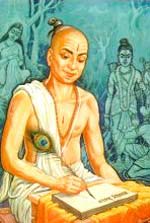 The day being Tulsidas Jayanthi (commemoration of the birth of Tulsidas) we present an important saint of India. (b. 1543?, probably Rajapur, India, d.1623, Varanasi), Tulsidas was an Indian sacred poet whose principal work, the Rama charita-manasa. (“Sacred Lake of the Acts of Rama”), became an extremely popular form of devotional literature which has exercised an abiding influence on the devotional culture of North India.
The day being Tulsidas Jayanthi (commemoration of the birth of Tulsidas) we present an important saint of India. (b. 1543?, probably Rajapur, India, d.1623, Varanasi), Tulsidas was an Indian sacred poet whose principal work, the Rama charita-manasa. (“Sacred Lake of the Acts of Rama”), became an extremely popular form of devotional literature which has exercised an abiding influence on the devotional culture of North India.
He belonged to no sect, he founded no sect, he was just an simple Hindu conforming to caste and worship. While worshipping Rama as supreme in his writings and sacred poems, he also paid attention to Krishna and Siva. He is famous for the Tulsai-Kirtan-Ramayan (or Tulsidas’s Song of Rama), throughout Northern India. It is recognised as the “Bible” of millions in North India and is probably more familiar to persons in North India than the Bible is to the average westerner. Many devotees know its most famous verses.
There are numerous traditions concerning him, some of which may be accepted with confidence, He was said to be born at Rajapur, in what is now called Uttar Pradesh, circa 1532 – 1543 and to have been a Sarwaria Brahmana of the Parasara gotra. His father’s name was Atmarama, and his mother was named Hulasi, and his own name being Rama Bhola. In one of his verses he tells us that he was abandoned by his parents immediately after his birth, and it can be assumed from this that he was probably one of those unfortunate children known as abhuktamula, born under the beginning of the period of the Nakshatra by name Mula. Such a child is said to be destined to destroy its father, and the only remedy is to abandon it on its birth, or, at best, so to arrange that its parents shall not look upon its face during the first eight years of its existence.
Traditions tell that his mother died the very next day, and that Rama Bhola was wet-nursed until the age of 5 when he was given over to a wandering Sadhu. Other folk traditions also mention the street urchin Rama Bhola.
The wandering Sadhu re-named him Tulasi-Dasa (Servant of the tulasi plant) in honour of the sacred leaf used in the ceremony of purification of the infant, and by this name he was henceforth known. With this Sadhu, who was probably also his guru, Naranari-Dasa, he wandered all over Northern India. From his guru he learnt the story of Rama, but owing to his ignorance (of Sanskrit) he could not at first grasp its importance. At length, after frequent hearings, he learnt it so far as his intelligence would allow, and then determined to write it in the vernacular for his own benefit and for that of others similarly situated.
When he grew up, he lived as a householder, and married a girl named Ratnavali, the daughter of Dinabandhu Pathaka, by whom he had a son named Taraka, who died at an early age. He was devoted to his wife and could not bear to be separated from her. She was a firm Vaisnava, and on one occasion, when she had gone on to visit to her people, she reproached him for following her and for not showing equal affection to Rama. Struck with remorse, Tulasi-Dasa at once left her and took to an ascetic life. He is said to have seen her only once again in after years, and then not to have recognised her.
With his base at first in Ayodhya and subsequently in Benares, he made long journeys over Northern India preaching the gospel of Rama. At first he met with considerable opposition, but his holy life and his attractive personality conquered all obstacles and, even in Benares, the headquarters of Siva-worship, he won universal respect. A wealthy landowner of Benares named Todar Mall (who is to be distinguished from Akbar’s finance minister of the same name) was one of his closest friends, and a touching poem which Tulsidas wrote on his death has survived among his most cherished verses. After Todar Mall’s death his heirs quarrelled as to the disposal of the property, and referred the matter to Tulasi-Dasa as arbitrator. The deed of arbitration in his handwriting is still in existence and is dated A.D. 1612.
Tulasi Dasa was a Smarta Vaisnava; i.e., while a devotee of Ramachandra, he also adhered to the tradition of ordinary Hinduism and followed the general religious customs of his caste. This involved, among other things, the worship of Siva and the practice of eating his meals apart. In both respects he differed from the Vairagi Vaisnavas, who had abandoned tradition, and who worshipped only Vishnu in one or other of his incarnations and ate in company. During his stay in Ayodhya he associated with these Vairagi Vaisnasvas and there compiled the first three cantos of the Rama-charita-manasa. Subsequently, being unable to agree with them on points of discipline, he migrated to Benares and there completed the poem.
His devotion to Ramachandra (Lord Rama) as an incarnation of the Supreme is illustrated by the content of his works. With two exceptions, they all deal directly or indirectly with that deity. One work is a collection of hymns in praise of Krishna; another work is a short poem describing Siva’s marriage with Parvati, a subject also treated at some length as an episode in the Rama-charita-manasa. Over 20 works are attributed to Tulsidas. Some are apocryphal, some are written by others with a similar name, and others bear accretions from later readers and would be poets. The jury is still out on exactly which works may be attributed to Tulsidas, but source criticism, analysis and redaction criticism are bearing fruit.
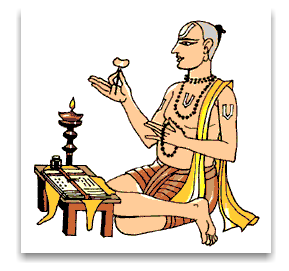
The Rama-charita-manasa expresses par excellence the religious sentiment of bhakti (“loving devotion”) to the avatar of Vishnu by name Rama, who is regarded as the chief means of salvation. Although Tulsidas was above all a devotee of Rama, he remained a follower of the more generally accepted traditions and customs of Hinduism rather than a strict sectarian, and his poem gives some expression both to orthodox monistic Advaita doctrine and to the polytheistic mythology of Hinduism – though these are everywhere subordinated to his expression of devotion for Rama. His eclectic approach to doctrinal questions meant that he was able to rally wide support for the worship of Rama in northern India, and the success of the Rama-charita-manasa has been a prime factor in the replacement of the Krishna cult by the cult of Rama as the dominant religious influence in that area.
The Rama-charita-manasa was written between 1574 and 1576 or 1577. A number of early manuscripts are extant – some fragmentary – and one is said to be an autograph. The oldest complete manuscript is dated 1647. The poem, written in Awadhi, an Eastern Hindi dialect, consists of seven cantos of unequal lengths. Although the ultimate source of the central narrative is the Sanskrit epic Ramayana, Tulsidas’ principal immediate source was the Adhyatma Ramayana, a late medieval recasting of the epic that had already sought to harmonize the Advaita system and the Rama cult. The influence of the Bhagavata Purana, the chief scripture of the Krishna cult, is also discernible, with that of a number of minor sources.
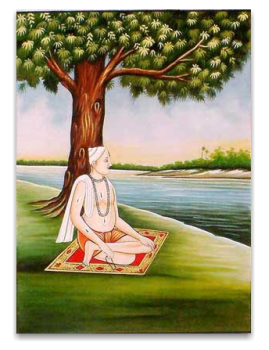
One popular tradition relates how Tulsidas met Hanuman at a recitation of the Ramayana and asked Him for a vision of Rama. However, when the Lord appeared before him walking through a forest with Lakshmana in the guise of Princes, Tulsidas did not recognize either, and according to some ancient authorities, petitioned Hanuman for another manifestation of Rama. This time he did recognise the Lord with bow and arrow.
Other legends speak of Tulsidas thrown into jail because he refused to perform a miracle for the Emperor Akbar and an army of monkeys subsequently attacking the jail and setting Tulsidas free. Two other legends have stronger currency. Once Tulsidas was to be set upon by robbers. When the robbers approached his abode where he was writing, the robbers found the house guarded by two fierce looking guards. In another tradition, jealous Brahmins attempted to discard the Rama-charita-manasa because it was not written by a pundit or a brahmin; a sorcerer was paid to do a rite against Tulsidas. The Rama-charita-manasa was placed in the bottom of the pile of texts. Locked in temple overnight. Next morning, the text was found at the top of the pile of scripts.
A prose translation of the Rama-charita-manasa, with a useful introduction, is W.D.P. Hill’s The Holy Lake of the Acts of Rama (1952). This is reprinted and made available by the Government of India.
Tulsidas and Sri Hanuman
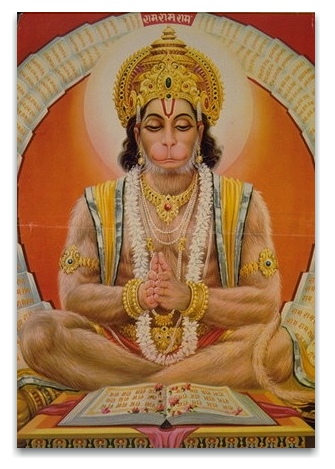
The Devotion of Tulsidas
There were many Sages and Sadhaks who were ready to sacrifice their lives for the sake of Rama. Tulsidas was a great devotee of God who lived on the Chitrakoota mountain. Every day after bath, he would offer holy water to a tree. One day, a spirit appeared in front of him and said: “Oh master, while you discourse on the Ramayana, there is a person, an old man who comes here first and is the last one to leave. Tomorrow, you must cling to his feet and ask for a boon.” The Spirit told this and disappeared.
On the next day, Tulsidas was busy preparing sandal paste and singing the name of Rama. After sometime, the old Brahmin came there. Tulsidas began discoursing on the Ramayana. At the end of the discourse, everyone went away except the Brahmin. Tulsidas went to him and fell at his feet. The Brahmin asked Tulsidas what boon he wanted. Tulsidas replied: “I want to have the darshan of the beautiful form of Sri Rama.” The Brahmin then said: “You will have the darshan of Sri Rama in a few days.” Who was this Brahmin? It was none else than Hanuman. He would present himself wherever the glory of Rama is sung. Hanuman always passes into rapture while listening to the glory Rama.
A few days later, a boy of tender age came to Tulsidas when he was preparing sandal paste for the Lord. He approached Tulsidas and said: “Oh grand sire, will you give some paste to me?” Tulsidas readily agreed to do this favour for the boy. While he was giving the paste to the boy, the birds on the tree felt pity for Tulsidas, since he did not recognise that the boy was the same Lord Rama, for whom he had been pining for so many years. The Lord is everywhere:
Whether you are in the forest or in the desert,
Whether you are in town or village,
Whether you are on the mountain-top or mid-stream,
The Lord helps the hapless ones.
Two days after this incident, the old man asked Tulsidas whether he had seen the Lord on the previous day. Tulsidas replied in the negative. Then the old man said: “Who do you think came yesterday in the form of a boy to take sandal paste from you? All forms are His and all names are His. It is foolishness to worship Him in one form only. Ramachandra is the Indweller of your heart. Your heart is the altar of God. Don’t install any one in the altar of your heart except the Lord.
My son, you may give room to your kith and kin in any part of your house, but do not install them in the altar of your shrine. Kith and kin come in the middle and go away in the middle. Serve them, but do not give your heart to them. Fill your heart with compassion. A heart laden with compassion is the temple of the Lord. Hrudh + daya makes Hrudaya.” Hanuman taught this lesson to Tulsidas and disappeared.
This page last updated 21 January 2023
This page first updated 18 March 2001
© Saieditor.com
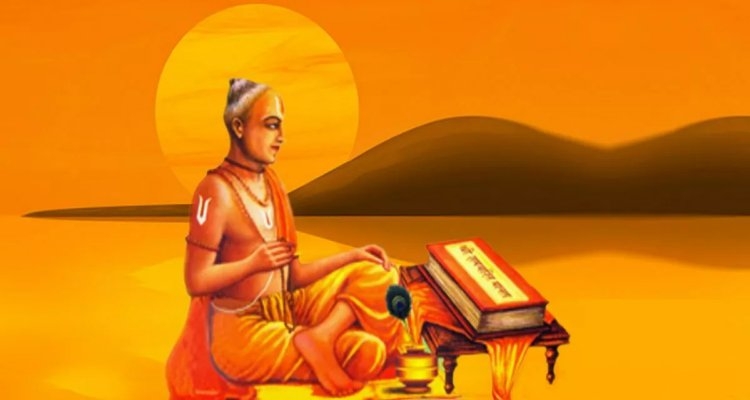
![]()

